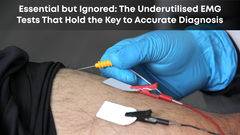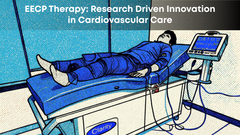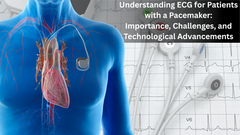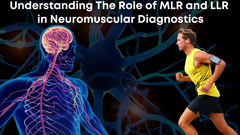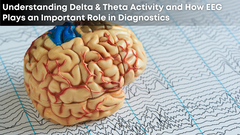Essential but Ignored: The Underutilized EMG Tests That Hold the Key to Accurate Diagnosis
Electromyography (EMG) and nerve conduction studies (NCS) are indispensable tools in modern neurodiagnostics. They help clinicians evaluate the electrical activity of muscles and the integrity of peripheral nerves, playing a central role in diagnosing neuropathies, myopathies, and neuromuscular junction disorders.
Yet, despite the sophistication of modern EMG devices, clinical practice often focuses narrowly on basic motor and sensory conduction studies and routine needle EMG. This leaves out several advanced tests that an EMG device can perform—tests that are crucial for early detection, accurate differential diagnosis, and improved patient outcomes.
Neglecting these tests can lead to misdiagnosis, delayed treatment, or unnecessary interventions. In this blog, we explore the most overlooked but highly significant EMG tests, their uses, and why they should become standard practice.
1. Repetitive Nerve Stimulation (RNS)
What it is:
RNS measures the change in compound muscle action potential (CMAP) after a series of repetitive stimulations to a motor nerve.
Clinical Significance:
- Gold standard for evaluating neuromuscular junction disorders.
- Detects the decremental response characteristic of myasthenia gravis (MG).
- Identifies incremental responses in Lambert-Eaton myasthenic syndrome (LEMS).
Consequences if ignored:
Patients with vague fatigue, fluctuating muscle weakness, or diplopia may go undiagnosed or be misclassified as having nonspecific neuropathies. Delayed diagnosis of MG or LEMS means delayed immunotherapy or tumour screening (as LEMS is often paraneoplastic).
Alternatives:
Single-Fiber EMG (SFEMG) is more sensitive but technically demanding. RNS remains a practical, reliable first-line test.
2. F-Waves
What it is:
F-waves are late responses obtained by supramaximal stimulation of a motor nerve, assessing conduction in the entire length of the motor neuron, including proximal segments.
Clinical Significance:
- Detects proximal conduction abnormalities not accessible by routine distal NCS.
- Early diagnostic tool for Guillain-Barré syndrome (GBS).
- Useful in radiculopathies and plexopathies, where distal conduction studies can appear normal.
Consequences if ignored:
Clinicians risk missing early demyelination in GBS, delaying lifesaving interventions such as IVIG or plasma exchange. Proximal lesions may be overlooked until irreversible deficits occur.
Alternatives:
Magnetic stimulation of spinal roots (transcranial magnetic stimulation) can test similar pathways but is not widely available compared to F-waves.
3. H-Reflex
What it is:
The H-reflex is essentially the electrical equivalent of the ankle jerk reflex. It evaluates afferent sensory and efferent motor conduction through the reflex arc.
Clinical Significance:
- Highly sensitive for detecting S1 radiculopathy.
- Useful in polyneuropathies, particularly when assessing large-fibre function.
- Helps differentiate between peripheral nerve and root involvement.
Consequences if ignored:
Clinicians may overlook subtle radiculopathies that do not produce overt weakness or sensory deficits, leading to prolonged pain and unnecessary imaging studies.
Alternatives:
Somatosensory evoked potentials (SSEPs) provide similar information but are less specific and more technically demanding.
4. Late Responses (A-Waves and Blink Reflex)
What they are:
- A-waves: Abnormal late responses seen in motor conduction studies.
- Blink reflex: Assesses trigeminal and facial nerve pathways via corneal or supraorbital stimulation.
Clinical Significance:
- Blink Reflex: Essential for diagnosing cranial neuropathies, trigeminal neuralgia, brainstem lesions, and multiple sclerosis.
- A-waves: Indicators of chronic neuropathies, motor neuron disease, or demyelinating conditions.
Consequences if ignored:
Cranial neuropathies may go undetected until more invasive testing or an MRI is ordered, delaying treatment. Subtle demyelinating disease markers may be missed.
Alternatives:
MRI can detect brainstem lesions, but lacks the functional assessment that the blink reflex provides.
5. Single-Fiber EMG (SFEMG)
What it is:
A highly specialized form of EMG that measures jitter (variation in time between action potentials of adjacent muscle fibres).
Clinical Significance:
- The most sensitive test for neuromuscular junction disorders.
- Detects subclinical changes in myasthenia gravis even when RNS and antibodies are negative.
- Valuable for patients with non-specific fatigue or suspected autoimmune neuromuscular disease.
Consequences if ignored:
Patients with early MG may be missed until their condition worsens significantly, leading to myasthenic crises that could have been prevented with early treatment.
Alternatives:
No alternative matches its sensitivity. RNS and antibody testing can complement SFEMG but cannot replace it.
6. Quantitative EMG (QEMG)
What it is:
Unlike qualitative EMG, QEMG objectively measures motor unit potential (MUP) parameters—amplitude, duration, and recruitment patterns.
Clinical Significance:
- Differentiates neuropathy from myopathy more precisely.
- Provides objective tracking of disease progression in conditions such as ALS and muscular dystrophies.
- Reduces subjectivity in EMG interpretation, especially for less experienced clinicians.
Consequences if ignored:
Misclassification of disorders may occur. Patients with early myopathy might be misdiagnosed as having neuropathy, leading to inappropriate investigations or therapies.
Alternatives:
MRI and muscle biopsy may assist, but are invasive or expensive. QEMG provides a real-time, non-invasive alternative.
7. Autonomic Function Tests (SSR, R-R Interval Variation)
What they are:
- Sympathetic Skin Response (SSR): Measures changes in sweat gland activity.
- R-R Interval Variation: Assesses parasympathetic control of heart rate.
Clinical Significance:
- Early detection of autonomic neuropathy in diabetes.
- Useful for small fibre neuropathies, which often precede large fibre involvement.
Consequences if ignored:
Diabetic patients may progress silently into advanced neuropathy with severe complications such as foot ulcers and autonomic crises (orthostatic hypotension, arrhythmias).
Alternatives:
Heart rate variability analysis and quantitative sudomotor axon reflex testing (QSART) are alternatives but require specialized equipment.
Why Are These Tests Ignored?
Several reasons explain why these critical tests are often sidelined:
- Time Constraints: Advanced studies require more time and necessitate careful interpretation.
- Lack of Awareness: Many physicians and technicians are not fully trained in their application.
- Equipment Limitations: Not all EMG devices support advanced protocols.
- Focus on Quick Answers: Busy clinical setups often prioritise basic conduction tests over comprehensive evaluations.
The Cost of Neglect
Ignoring these tests leads to:
- Missed Early Diagnosis: Conditions such as GBS, MG, or diabetic neuropathy may be detected late.
- Misdiagnosis: Patients may undergo unnecessary imaging, biopsies, or even surgeries.
- Disease Progression: Disorders like myasthenia gravis or ALS may worsen before intervention.
- Higher Healthcare Costs: Delayed diagnosis leads to prolonged treatment and complications.
How Clarity Medical Bridges the Gap
Clarity Medical’s EMG-NCS systems are designed not just for routine conduction studies but for the complete spectrum of advanced tests. By enabling:
- RNS and SFEMG for neuromuscular junction disorders.
- F-waves and H-reflex for proximal neuropathies.
- Blink reflex and A-waves for cranial and chronic neuropathies.
- Quantitative EMG for objective analysis.
- Autonomic testing for small fibre dysfunction.
Clarity ensures clinicians do not miss the subtle but critical details.
In short, choosing the right EMG device means transforming your lab from routine testing to comprehensive neurodiagnostics.
Conclusion
An EMG device is much more than a tool for basic nerve conduction. When fully utilised, it becomes a comprehensive neurological diagnostic platform. Ignored tests such as RNS, F-waves, H-reflex, SFEMG, quantitative EMG, and autonomic assessments hold the key to early detection, accurate diagnosis, and improved patient care.
Neglecting them is not just an oversight—it is a missed opportunity to change patient outcomes. With modern EMG systems such as those offered by Clarity Medical, clinicians can unlock the full potential of neurodiagnostics and deliver care that is both timely and precise.






